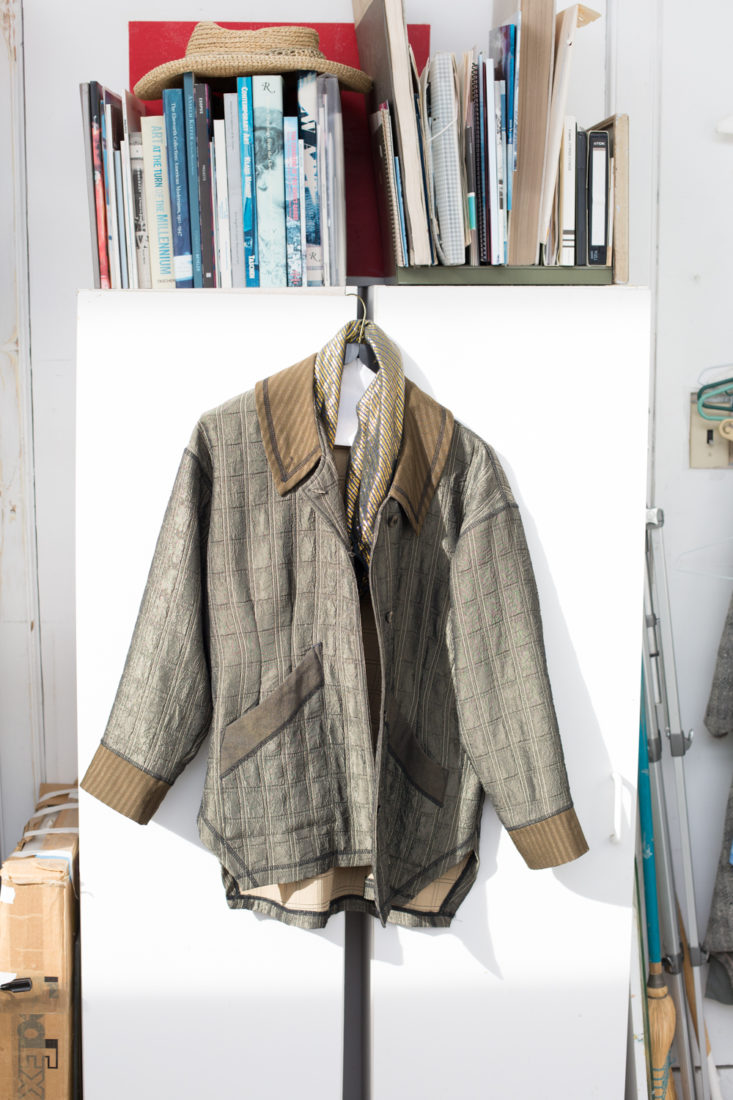


Q: What was one of your first creative memories?
If you mean my own creation – nothing but a blur of mud and rose petals and small bottles of water to make perfume. But as a witnessing I’d have to go with the theater of high Mass….gilded robes, incense, a chorus of voices, red shoes, Latin mumbo jumbo, an altarpiece the size of my body studded with jewels. Pure spectacle made grander by my innocence.
Q: Who inspires you daily?
My husband and daughter which sounds schmaltzy but is the truth of where I begin and end.
Q: What are your weekly rituals?
Dance classes and the New York Times in bed on Sunday nights.
Q: How would your define your aesthetic both artistically and style-wise
My aesthetic relies on details that trigger fuller responses. I build images with layers of information that let the viewer track my thinking. I intentionally choreograph where their eye travels in the work, using distinctive marks or color as guides. With clothes I use a similar approach, letting accessories define the major pieces rather than the other way around.
Q: Who are the artists in or outside of your community that influence and/or inspire you?
I am absolutely an artist voyeur. I spy on everyone and relish the best of their work, local or national. But I’m influenced most by failings, work that falls short or feels vulnerable and slightly unmoored conceptually. I find the courage to keep going myself from seeing and thinking about what is missing in other talented people’s work. This being said lately I’ve been looking at artists tied to the Near East. Rabih Mroue’. Monir Shahroudy Farmanfarmaian. Shirin Neshat. Mona Hatoum.
And if I need just a kick of talent and diversity I look at VitaminD, a compilation of artist drawings that always inspire me.

“I’m influenced most by failings, work that falls short or feels vulnerable and slightly unmoored conceptually.”


Q : Tell us a bit about your recent trip to Beirut, why were you drawn to there and what did you discover?
My family is Lebanese. Just prior to the Arab Spring I did my first visit to Lebanon which included visits to the villages of my family. While their exodus was more than 100 years ago I became interested in the traces of their history and how their experience paralleled the current wave of migrants leaving the region. I returned to Beirut to continue research I had begun in Paris and Mexico City, both cities with large Arab citizens that have ties to the same time frame as my grandparent’s migration. There are photographic archives in each city that have proven to be informing for me.
The work I am making is intended to shed light on misunderstood cultural collisions that are the truth of the Middle East. I have learned that contrary to reports Lebanon is safe and inviting. I have learned that this fact is also something that could change in an instant and that has been completely absorbed into the psyche of the people. I learned that there are atrocities covered up by golf courses, shopping malls, media blackouts and the vagaries of war. I learned that the pivot point is the Lebanese civil war (not current Syria) and that the generation that fled at that time now has their children returning and reshaping the future. I also learned that a shared meal can buffer the worst possibility. I learned that Beirut remains a thoroughly cosmopolitan multilingual city. I learned that my connection is a potentially powerful perspective, even at a distance. I needed permission for that which is why I went back.
Q : What are you most interested in exploring in your artistic practice?
My own fears about being honest and specific around topics that many don’t want to address nor understand. And I want to do that using the entre of beauty which is always the great seductress for ideas that are complicated. My hand is beautiful. My sources in this moment sometimes are not. The final quest is identifying some distinct almost incidental item or event that can carry the work. This is my greatest challenge but where I want to go.

